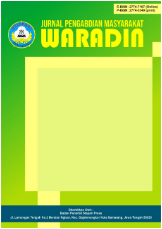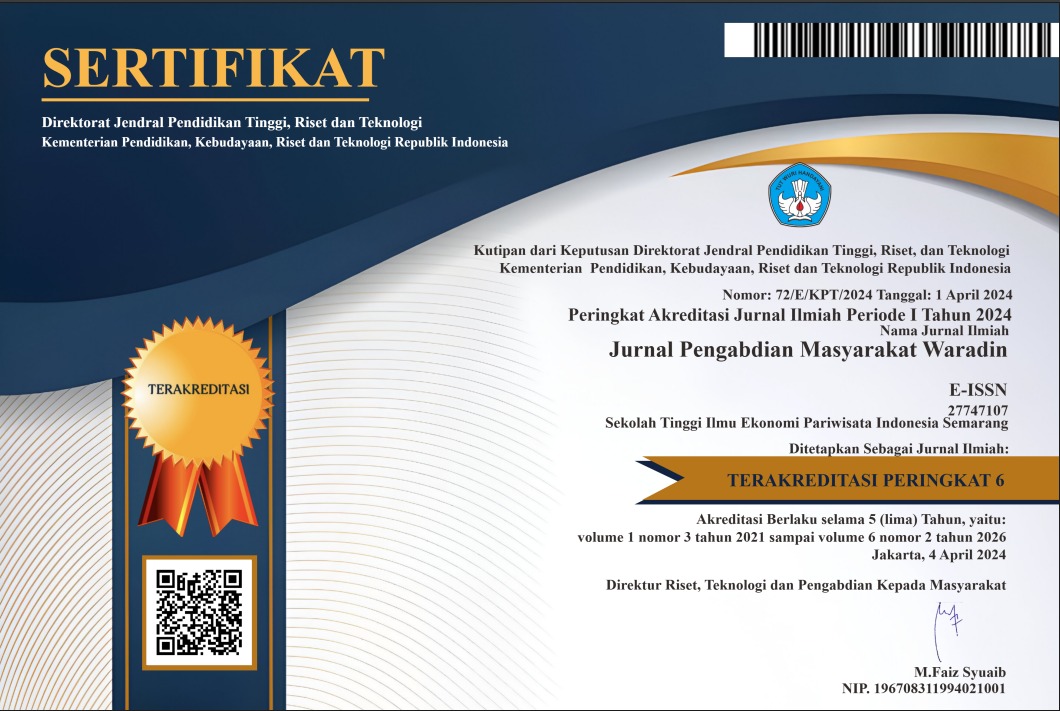Partisipasi Lansia dalam Cek Kesehatan di Desa Mantang Baru
DOI:
https://doi.org/10.56910/wrd.v5i3.823Keywords:
Elderly Participation, Health Check-up, Health Services, Mantang Baru Village, Public HealthAbstract
This study discusses the level of participation of elderly people in Mantang Baru Village in routine health checks. The main objective is to see how active they are in participating and what makes them interested or reluctant to attend health checks. This study uses a quantitative approach with the aim of measuring the level of participation of elderly people in health check activities in Mantang Baru Village. Data was collected using direct surveys of each elderly person's home, which contained questions related to the frequency of health check visits, motivation, and barriers to health checkups for the elderly. The population in this study was all elderly people aged 60 years and above who reside in Mantang Baru Village. The results showed that most elderly people were quite diligent in attending health checkups because they realized the importance of maintaining their physical condition. Factors such as family support, ease of access to health check locations, and their knowledge about health significantly influence their decision to participate. In conclusion, if health education and facilities can be further improved, elderly participation will certainly increase, thereby helping to maintain their health better. The role of health cadres is very significant in encouraging elderly participation through a personal approach and continuous education.
References
Achadi, E. L., Amini, R., & Puspitasari, I. (2021). Stunting di Indonesia: Tantangan dan upaya penanggulangannya. Gizi Indonesia, 44(2), 123–132. https://doi.org/10.36457/gizindo.v44i2.580
Armand, F. (2003). Social marketing models for product-based reproductive health programs: A comparative analysis. Occasional Paper Series. Washington, DC. Retrieved from http://www.cmsproject.com
Bator, R. J., Bryan, A. D., & Schultz, P. W. (2011). Who gives a hoot?: Intercept surveys of litterers and disposers. Environment and Behavior, 43(3), 295–315. https://doi.org/10.1177/0013916509356884
Belair, A. R. (2003). Shopping for your self: When marketing becomes a social problem (Dissertation). Concordia University, Montreal, Quebec, Canada.
Chain, P. (1997). Same or different?: A comparison of the beliefs Australian and Chinese university students hold about learning’s proceedings of AARE Conference. Swinburne University. http://www.swin.edu.au/aare/97pap/CHAN97058.html
Hanafi, S. H., & Zamli, Z. (2025). Peningkatan pengetahuan dan perilaku hidup sehat lansia melalui penyuluhan Posyandu Lansia di wilayah UPTD Puskesmas Meo-Meo. Jurnal Pengabdian Masyarakat Bangsa, 3(5), 2297–2301. https://doi.org/10.59837/jpmba.v3i5.2711
Hidayati, S. N. (2016). Pengaruh pendekatan keras dan lunak pemimpin organisasi terhadap kepuasan kerja dan potensi mogok kerja karyawan. Jurnal Maksipreneur: Manajemen, Koperasi, dan Entrepreneurship, 5(2), 57–66. http://dx.doi.org/10.30588/SOSHUMDIK.v5i2.164
Kotler, P., & Lee, N. R. (2009). Up and out of poverty: The social marketing solution. Pearson Education, Inc.
Lindawati. (2015). Analisis faktor yang memengaruhi perilaku ekonomi dan kesejahteraan rumah tangga petani usahatani terpadu padi-sapi di Provinsi Jawa Barat [Tesis, Institut Pertanian Bogor]. IPB Repository. http://repository.ipb.ac.id/handle/123456789/85350
LPPSP. (2016). Statistik Indonesia 2016. Badan Pusat Statistik. https://www.lppsp.go.id/index.php/publikasi/326
Muharani Ms, N. (2025). Optimalisasi Posyandu Lansia dalam menjaga kesehatan fisik masyarakat lansia di Nagari Kampung Dalam, Kecamatan Lubuk Tarok, Kabupaten Sijunjung. Jurnal Pengabdian Masyarakat Bangsa, 3(5), 2192–2199. https://doi.org/10.59837/jpmba.v3i5.2645
Norsyaheera, A. W., Lailatul, F. A. H., Shahid, S. A. M., & Maon, S. N. (2016). The relationship between marketing mix and customer loyalty in hijab industry: The mediating effect of customer satisfaction. In Procedia Economics and Finance (Vol. 37, pp. 366–371). Elsevier B.V. https://doi.org/10.1016/S2212-5671(16)30138-1
Pratiwi, S. A., Wilson, W., & Fitrilinda, D. (2024). Peranan kader Posyandu Lansia dalam meningkatkan kesejahteraan sosial lansia di Desa Sibuak Kecamatan Tapung Kabupaten Kampar. JERUMI: Journal of Education Religion Humanities and Multidiciplinary, 2(1), 157–161. https://doi.org/10.57235/jerumi.v2i1.1752
Rahman, S., & Sari, M. (2021). Aksesibilitas geografis terhadap pemanfaatan layanan kesehatan lansia di wilayah pedesaan. Jurnal Geografi Kesehatan, 9(1), 23–35.
Risdwiyanto, A. (2016, Februari 22). Tas kresek berbayar, ubah perilaku belanja? Kedaulatan Rakyat, p. 12.
Risdwiyanto, A., & Kurniyati, Y. (2015). Strategi pemasaran perguruan tinggi swasta di Kabupaten Sleman Yogyakarta berbasis rangsangan pemasaran. Jurnal Maksipreneur: Manajemen, Koperasi, dan Entrepreneurship, 5(1), 1–23. http://dx.doi.org/10.30588/SOSHUMDIK.v5i1.142
Sari, L. P., & Wulandari, R. (2023). Kesadaran kesehatan lansia dan partisipasi dalam program pemerintah. Jurnal Kebijakan Kesehatan, 11(2), 89–98.
StatSoft, Inc. (1997). Electronic statistic textbook. StatSoft Online. http://www.statsoft.com/textbook/stathome.html
Wijaya, I. K., Putri, D. A., & Santoso, B. (2022). Pengaruh dukungan keluarga terhadap motivasi lansia dalam menjaga kesehatan. Jurnal Keluarga dan Kesehatan, 14(4), 201–212.







